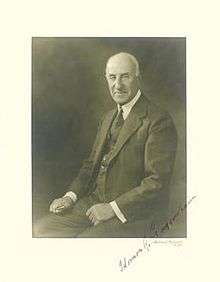Solomon R. Guggenheim
Solomon Robert Guggenheim (February 2, 1861 – November 3, 1949) was an American businessman and art collector. He is best known for establishing the Solomon R. Guggenheim Foundation and the Solomon R. Guggenheim Museum in New York City.
Solomon R. Guggenheim | |
|---|---|
 | |
| Born | Solomon Robert Guggenheim February 2, 1861 Philadelphia, Pennsylvania |
| Died | November 3, 1949 (aged 88) |
| Occupation | businessman, art collector, philanthropist |
| Known for | Solomon R. Guggenheim Foundation Solomon R. Guggenheim Museum |
| Spouse(s) | Irene Rothschild (m. 1895) |
| Children | Eleanor (1896–1992), Gertrude (1898–1966), Barbara (1904–1985) |
| Family | Peggy Guggenheim (niece) |
Guggenheim was born into a wealthy mining family, and he founded the Yukon Gold Company in Alaska, among other business interests. He began collecting art in the 1890s, and he retired from his business after World War I to pursue art collecting. He eventually focused on modern art under the guidance of artist Baroness Hilla von Rebay, creating an important collection by the 1930s and opening his first museum in 1939.
Biography
Early life
Guggenheim was born in Philadelphia, Pennsylvania, son of Meyer and Barbara Guggenheim and brother of Simon, Benjamin, Daniel and five other siblings.[1] He was of Swiss and Ashkenazi Jewish ancestry.
Following studies in Switzerland at the Concordia Institute in Zürich, he returned to the United States to work in the family mining business, later founding the Yukon Gold Company in Alaska. In 1891, he turned around the Compañia de la Gran Fundición Nacional Mexicana.[1] He married Irene Rothschild, daughter of Victor Henry Rothschild, in 1895.[2] His children were Eleanor (1896–1992) (later Lady Castle Stewart after her marriage to Arthur Stuart, 7th Earl Castle Stewart), Gertrude (1898–1966) and Barbara Guggenheim (1904–1985).[1]
He began collecting works of the old masters in the 1890s. He retired from his business in 1919 to devote more time to art collecting and in 1926, met Baroness Hilla von Rebay.[3] In 1930, they visited Wassily Kandinsky’s studio in Dessau, Germany, and Guggenheim began to purchase Kandinsky's work. The same year, Guggenheim began to display the collection to the public at his apartment in the Plaza Hotel in New York City. Guggenheim's purchases continued with the works of Rudolf Bauer, Marc Chagall, Fernand Léger and László Moholy-Nagy.[3]
Foundation and museum
In 1937, Guggenheim established the Solomon R. Guggenheim Foundation to foster the appreciation of modern art, and in 1939, he and his art advisor, Baroness Rebay, opened a venue for the display of his collection, the Museum of Non-Objective Painting, at 24 East 54th Street.[1][4] Under Rebay's guidance, Guggenheim sought to include in the collection the most important examples of non-objective art available at the time, such as Kandinsky's Composition 8 (1923), Léger's Contrast of Forms (1913) and Robert Delaunay's Simultaneous Windows (2nd Motif, 1st Part) (1912).[5]
By the early 1940s, the museum had accumulated such a large collection of avant-garde paintings that the need for a permanent building to house the art collection had become apparent.[6] In 1943, Guggenheim and Rebay commissioned architect Frank Lloyd Wright to design a new museum building.[3][7] In 1948, the collection was greatly expanded through the purchase of art dealer Karl Nierendorf's estate of some 730 objects, notably German expressionist paintings.[5] By that time, the museum's collection included a broad spectrum of expressionist and surrealist works, including paintings by Paul Klee, Oskar Kokoschka and Joan Miró.[5]
Guggenheim died in 1949 on Long Island, New York, and the museum was renamed the Solomon R. Guggenheim Museum in 1952. The museum opened in New York City on October 21, 1959.[1]
Legacy
In addition to the New York Museum, the Guggenheim Foundation operates, among other things, the Guggenheim Museum Bilbao in Spain and the Peggy Guggenheim Collection in Venice, which was established by Guggenheim's niece, Peggy Guggenheim.
See also
Notes
- Michael Boyan (2006). "Solomon R. Guggenheim". Penn State University Libraries. Archived from the original on 2011-11-15. Retrieved 2011-10-21.
- "Irene Rothschild Guggenheim", Jewish Women's Archive, accessed May 28, 2013. Irene Rothschild was not related to the Rothschild banking family.
- "Biography: Solomon R. Guggenheim". Guggenheim Foundation. Retrieved 2011-10-21.
- Vail, pp. 25 and 36
- Calnek, Anthony, et al. The Guggenheim Collection, pp. 39–40, New York: The Solomon R. Guggenheim Foundation, 2006
- Winter, Damon. "Solomon R. Guggenheim Museum", The New York Times, October 21, 2009, accessed March 7, 2012
- Vail, p. 333
References
- Davis, John H. (1994) [1989]. The Guggenheims: An American Epic. SP Books. ISBN 1561713511.
- Vail, Karole (ed) (2009). The Museum of Non-Objective Painting. New York: The Solomon R. Guggenheim Foundation.CS1 maint: extra text: authors list (link)